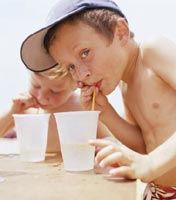| |
 Many
school going children are in the habit of wanting chocolates and
sweets, several times throughout the day. Some children are seen
to indulge in very large quantities of rice. This is due to the
fact that they are at an important stage of growth and the need
for energy is great so the craving for sugar and starch is high.
However a proper balance of nutrients namely carbohydrate and protein
is very important to ensure good growth and also prevent unhealthy
eating habits from setting in now. In such cases what we normally
see is that the protein in the diet may be quite low and hence the
children get hungry and the stomach feels empty an hour or so after
a meal and they start looking out for chocolates and sweets. Many
school going children are in the habit of wanting chocolates and
sweets, several times throughout the day. Some children are seen
to indulge in very large quantities of rice. This is due to the
fact that they are at an important stage of growth and the need
for energy is great so the craving for sugar and starch is high.
However a proper balance of nutrients namely carbohydrate and protein
is very important to ensure good growth and also prevent unhealthy
eating habits from setting in now. In such cases what we normally
see is that the protein in the diet may be quite low and hence the
children get hungry and the stomach feels empty an hour or so after
a meal and they start looking out for chocolates and sweets.
I would like
to explain what carbohydrate and protein foods are.Carbohydrates
are sugars and starch. Sugar is found in fruits, regular sugar,
jaggery, honey etc. Starch is mainly found in all vegetables and
cereals - rice, wheat, corn, ragi, jowar, bajra etc.
Protein is found in dhals, pulses, milk, milk products, egg, fish,
chicken, meats, and nuts.
The first thing to do is to check if in each meal the child is getting
both a carbohydrate as well as a protein food.
Only a glass of milk for breakfast is not balanced. Milk plus 2
slices of bread or cereal and milk or porridge with milk would be
ideal.
Similarly, milk and egg alone are only protein foods. Milk and egg
along with bread or chappathi would be ideal.
 Bread
and jam or bread and butter alone is not good as the protein is
missing. Egg or milk must go with it. Iddli and sambar or dosa are
good as they are in themselves a rice and dhal combination. Upma
must be eaten with curds or a glass of milk. Bread
and jam or bread and butter alone is not good as the protein is
missing. Egg or milk must go with it. Iddli and sambar or dosa are
good as they are in themselves a rice and dhal combination. Upma
must be eaten with curds or a glass of milk.
Most often lunches
and dinners are also poorly balanced. Lime rice, tamarind rice or
pulav alone gives only carbohydrates and sabji and chapathi again
are purely carbohydrate with protein missing. Dhal, pulses, non-veg,
egg or curd must be given with the above.
Kindly note
that raw eggs are useless in terms of protein as the egg cannot
be digested by the human body unless it is fully cooked. If eaten
raw it is completely excreted from the body.
We have also
seen that in many cases dhals and pulses are given very little importance.
Dhals and pulses are very good source of protein as well as vitamins
and minerals. They should be a part of the daily menu in the form
of dhals, sambars, and channa, rajma, moong sabjis or curries. They
must be eaten at least once a day and twice would be ideal. Vegetarian
children must learn to carry rice mixed with sambar or dhal for
lunch daily. Alternately they may be given lemon rice or a pulav
along with a channa or rajma preparation and some sabji. Those who
prefer chapathis may take 2 chapathi rolls, 1 roll filled with pulses
and another filled with sabji vegetables. Salad may be sent with
lunch.
Non- vegetarians may eat a chicken or egg along with a vegetable
roll and some salad.
When they return
from school care must be taken to see that a glass of milk and a
healthy snack like sandwiches, etc. are provided. This is not lunch
time but tea time and lunch meal should be eaten at school during
lunch time. Sandwiches may be made of vegetables, jam and egg or
cheese occasionally. Biscuits may be eaten and occasionally a little
noodle or idly, dosa may be eaten.
|
|